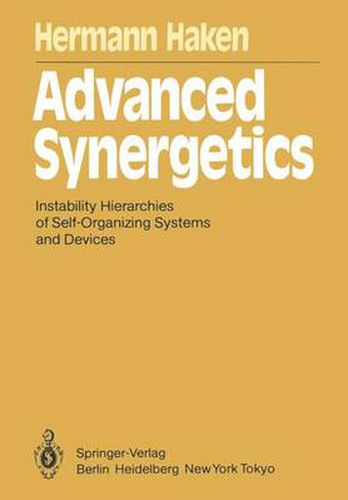Readings Newsletter
Become a Readings Member to make your shopping experience even easier.
Sign in or sign up for free!
You’re not far away from qualifying for FREE standard shipping within Australia
You’ve qualified for FREE standard shipping within Australia
The cart is loading…






This title is printed to order. This book may have been self-published. If so, we cannot guarantee the quality of the content. In the main most books will have gone through the editing process however some may not. We therefore suggest that you be aware of this before ordering this book. If in doubt check either the author or publisher’s details as we are unable to accept any returns unless they are faulty. Please contact us if you have any questions.
This text on the interdisciplinary field of synergetics will be of interest to students and scientists in physics, chemistry, mathematics, biology, electrical, civil and mechanical engineering, and other fields. It continues the outline of basic con cepts and methods presented in my book Synergetics. An Introduction, which has by now appeared in English, Russian, J apanese, Chinese, and German. I have written the present book in such a way that most of it can be read in dependently of my previous book, though occasionally some knowledge of that book might be useful. But why do these books address such a wide audience? Why are instabilities such a common feature, and what do devices and self-organizing systems have in common? Self-organizing systems acquire their structures or functions without specific interference from outside. The differentiation of cells in biology, and the process of evolution are both examples of self-organization. Devices such as the electronic oscillators used in radio transmitters, on the other hand, are man made. But we often forget that in many cases devices function by means of pro cesses which are also based on self-organization. In an electronic oscillator the motion of electrons becomes coherent without any coherent driving force from the outside; the device is constructed in such a way as to permit specific collective motions of the electrons. Quite evidently the dividing line between self-organiz ing systems and man-made devices is not at all rigid.
$9.00 standard shipping within Australia
FREE standard shipping within Australia for orders over $100.00
Express & International shipping calculated at checkout
This title is printed to order. This book may have been self-published. If so, we cannot guarantee the quality of the content. In the main most books will have gone through the editing process however some may not. We therefore suggest that you be aware of this before ordering this book. If in doubt check either the author or publisher’s details as we are unable to accept any returns unless they are faulty. Please contact us if you have any questions.
This text on the interdisciplinary field of synergetics will be of interest to students and scientists in physics, chemistry, mathematics, biology, electrical, civil and mechanical engineering, and other fields. It continues the outline of basic con cepts and methods presented in my book Synergetics. An Introduction, which has by now appeared in English, Russian, J apanese, Chinese, and German. I have written the present book in such a way that most of it can be read in dependently of my previous book, though occasionally some knowledge of that book might be useful. But why do these books address such a wide audience? Why are instabilities such a common feature, and what do devices and self-organizing systems have in common? Self-organizing systems acquire their structures or functions without specific interference from outside. The differentiation of cells in biology, and the process of evolution are both examples of self-organization. Devices such as the electronic oscillators used in radio transmitters, on the other hand, are man made. But we often forget that in many cases devices function by means of pro cesses which are also based on self-organization. In an electronic oscillator the motion of electrons becomes coherent without any coherent driving force from the outside; the device is constructed in such a way as to permit specific collective motions of the electrons. Quite evidently the dividing line between self-organiz ing systems and man-made devices is not at all rigid.